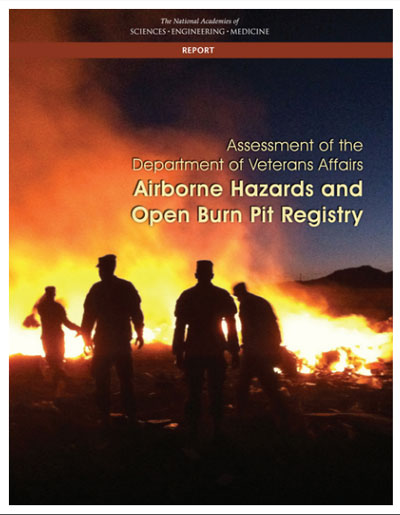An expert committee of the National Academies of Sciences, Engineering, and Medicine released a report in February 2017 critical of the Department of Veterans Affairs and its VA Burn Pit Registry and the questionnaire used to extract information from registry participants.
 The NAS committee found that the VA Burn Pit Registry, also known as the Airborne Hazards and Open Burn Pit (AH&OBP) Registry questionnaire, was flawed because of:
The NAS committee found that the VA Burn Pit Registry, also known as the Airborne Hazards and Open Burn Pit (AH&OBP) Registry questionnaire, was flawed because of:
• use of inappropriate format questions;
• confusing and ambiguous questions;
• asking for information on topics that provide little usable data, such as hobbies or places of childhood residence;
• failing to ask questions that could yield information related to relevant exposures;
• an individual could never update their answers if their conditions changed or worsened;
• risking “response fatigue” by requiring respondents to complete lengthy, repetitive questions on deployment before asking about health issues; and
• when individuals did not complete the questionnaire, the VA had no method for encouraging those individuals to finish and submit their responses.
NAS found that many questions had nonresponse rates of greater than 15%, and there was a lack of consistency among the types of questions that had high nonresponse rates.
Essentially, NAS found that VA’s collection methods made the registry useless for extrapolating its data to a larger population:
“This means that findings made using the registry data—which represent the experience of a small, non-random, self-selected sample—are not generalizable to the broader, eligible population and cannot be used for making inferences concerning it.”
The NAS committee also faulted the VA for a very small percentage (less than 2.5%) of respondents who indicated an interest in the optional exam for the conditions or illnesses they described in the questionnaire. The VA could not explain the low percentage, and did not actively engage the respondents on the need for an exam.
Even with the VA Burn Pit Registry’s limitations, the NAS committee found the exposure potential variables had “strong and consistent associations with self-reported asthma; any respiratory symptom; emphysema, chronic bronchitis, or chronic obstructive pulmonary disease (COPD); functional limitations due to lung or breathing problems; cardiovascular disease; and hypertension.”
The committee also said the registry limitations mean that any analysis is not generalizable because it only describes the conditions reported by those participating in the registry. So the registry is not useful in determining cause or estimating prevalence among the total eligible population of service members or veterans.
The NAS Recommendations on VA Burn Pit Registry
Among the committee’s recommendations:
• Eliminate questions addressing location, previous residences, non-military work history, home environment, community, and hobbies;
• VA should clarify the intent and purpose of the registry and develop a plan to integrate relevant VA and DoD data sources with registry data;
• Provide multiple methods for completing the questionnaire, such as a mail-in form or computer-assisted phone interview;
• VA should bring in external survey experts to are experience in Web-based questionnaire development
• VA should develop other means for evaluating potential health effects associated with airborne hazards and open burn pit exposures, such as a well-designed epidemiologic study;
• VA should let respondents know that the questionnaire has limitations for providing information that will improve VA health benefits programs or inform treatment for those exposed to burn pits;
• VA should develop a “concise version” of a participant’s questionnaire responses so that it would be useful in a routine clinical encounter — and make it available for download by the respondent; and
• VA should make it easier for registry participants to schedule and get a health examination by actively targeting respondents who indicate interest.
Background on the VA Burn Pit Registry
The VA was directed by Congress in 2013 to implement within a 12-month period an environmental health registry for “individuals who may have been exposed to toxic chemicals and fumes caused by open burn pits.” The goal of the registry was to capture information from military personnel who served in the Southwest Asia theater of operations beginning with Gulf War I in 1990 through 2016. The VA was also directed to include data from other VA and Department of Defense databases to lessen the responsibility on registry participants.
Statistics from the registry’s first 13 months:
• 47,000 individuals completed the questionnaire (representing 1.0% of eligible Gulf War veterans and 1.7% of eligible post-9/11 veterans)
• Approximately 7.5% of registry respondents service in the 1990-91 Gulf War only
• 96% of all respondents reported being exposed to a burn pit on at least one deployment
• 85.6% of Gulf War-era respondents reported exposure to smoke from oil well fires
• 85.2% reported exposure to dust storms
You can access the VA Burn Pit Registry here.
